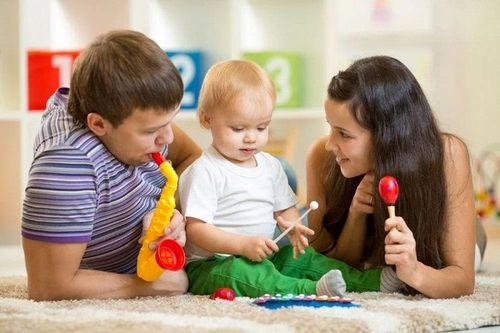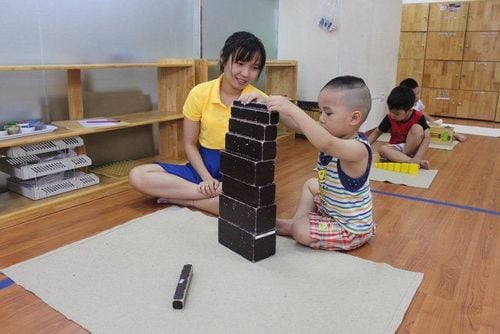This is an automatically translated article.
The article was professionally consulted by resident Doctor Duong Van Sy - Department of Pediatrics - Neonatology - Vinmec Hai Phong International General Hospital. Doctor has 09 years of experience in the field of Pediatrics.There are three basic skills to learn to read, namely: Syntax, grammar and phonetics. Syntax is how words, phrases, and clauses come together to create sentences and paragraphs. Semantics is the way words and sentences in a group link together to create a meaningful, content sentence. Phonetics here refers to the sounds that letters make and the relationship between written and spoken words, or the ability to understand sentences.
As children learn to read, they develop these cues as a group, not as individual words. However, most children will begin to understand syntax and semantics before phonics, which means they will learn the sentences in the book in left-to-right order before understanding how the combination of letters sh sounds. Parents can help children develop good reading comprehension skills by exposing children to books and reading every day, or simply reading aloud before bed or reading story books, recipes, and cooking. eat, ... anything children want to read and learn will help children stimulate their reading comprehension more.

1. About the syntax
A child can grasp syntax and have awareness of written language, which means he understands the structure of grammar and the relationship of words to each other. Syntax skills begin with an understanding of the structure of a book and the words and sentences within it. For example, for a small child, the book is like a toy, sometimes holding the book upside down, sometimes gnawing and using the book as a mat to sit on. But as children get older and go to school, they begin to understand that a book has its cover and back, words read from where to, left to right, and the book progresses page by page. When children grasp the structure of a book, children gradually learn to understand the inner words, which will simply start with words, phrases, paragraphs and gradually they can understand the whole text. As children read new books, they begin to understand the stops and starts, pauses in certain sentences, and the purpose of punctuation.Here are some ways for children to develop their syntax skills:
Read aloud each rhyme, word pattern found in the book. Books by authors like Dr. Seuss are great choices for beginners. The book has repeating word patterns like Brown Bear, Brown Bear, What do you see? When parents read books with their children, use your fingers to point to words. This will show children how a sentence progresses, a period that represents a break in the story, and other relationships between written and spoken language. Guide children to read aloud and expressively. Stop at all stops, emphasize exclamation points and question marks, and stop at commas. Exaggerating these cues helps children develop an appreciation for syntax. Use tenses in sentences, and have your child pick up a favorite book and try to change the tenses of each sentence in the book. Example: Change the text from “We are going to the park today” to “We went to the park yesterday.”. This technique will highlight the grammatical structure.

2. About the semantics of the sentence
Semantic skills include the ability to recognize and identify words, predict the plot of a story, understand characters and make sense of the whole story or part of a book, and then children are likely to discuss the book after reading it. Once children master the semantics, they will master the meaning of long blocks of text and understand synonyms and antonyms. Children can substitute words with similar meanings and distinguish words with similar meanings. Parents can encourage children to develop semantic skills by:Read books, tell fairy tales or books that help children expand their knowledge and understanding of the world around them. Talk about the book when your child is finished: Discuss the book with your child, even if the child is reading independently, parents can discuss the book together before and after story time. Ask your child to predict the ending and explain the theme of the story and what it means. Parents should ask children to predict the ending of the story by asking questions such as “What do you feel will happen next” or “How do you want the story to end” so that children gradually form their thoughts? only, practice more reading and speaking skills. Keep your child reading fluently: If a child is reading aloud, parents should not interrupt or interrupt a child's story. If children get stuck in some words that are difficult to read or understand, parents should explain the meaning and then move on to the next sentence to continue the story. This is good for the child in understanding the full meaning of the sentence and the rest of the story. Create a personal dictionary: If your child has difficulty with vocabulary, write down unknown words in a DIY dictionary for your child as he or she reads. Then look up the dictionary with your child, write down the definition, and encourage your child to review unknown words. In short, reading is still the best way to help children develop their own reading skills. As children get used to short stories, parents can encourage children to read longer books, especially books that must be read in a few days or weeks. Longer books help children develop memory, remember what they read (characters, events) and judge what might happen next. For children who read worse, it may be necessary to review the part they have read before before moving on to a new chapter, at first it may be boring for children to forget the previous parts, but after a while, their thinking If children improve, their memory will be better, no need to review again.

3. About phonetics
Phonology is part of the reading process, the child's ability to understand the sounds that letters make. To help children develop this skill, parents should encourage children to do the following:Go through rhymes, rhymes, and songs with your child. For each rhyme, point out the same or nearly identical words to discuss the difference. Use alphabet books to discuss similar and different words. Introduce children to new articles and magazines every day. Use phonetic skills to pronounce words and semantic skills to figure out meaning based on the context of a story. Parents need to ask children to read to themselves, when children come across a new or difficult word, pronounce and define it for them, then the child reads the whole sentence. Learning to read is a process that requires children to master three basic skills. These skills are syntax, semantics, and phonetics. Syntax (grammar and punctuation) is how words, phrases, and clauses come together to create sentences and paragraphs. Like any other developmental process, how quickly a child learns to read varies from child to child and this does not mean that parents need to worry if a child may read slower than other children. other.
Please follow the website: Vinmec.com regularly to update many other useful information.
Please dial HOTLINE for more information or register for an appointment HERE. Download MyVinmec app to make appointments faster and to manage your bookings easily.
References: babycenter.com, verywellfamily.com














